Do you have a question about the Bender A-ISOMETER IR425 and is the answer not in the manual?
Monitors insulation resistance of unearthed AC/DC control circuits.
General safety guidelines for Bender products.
Crucial safety precautions specific to the insulation monitoring device.
Describes how the device generates a pulsating measuring voltage.
Automatically sets response values upon first connection.
Device performs automatic or manual self-tests for faults.
Indicates device malfunctions with error codes and LED/relay status.
Delays alarm indication after power connection.
Delays alarm indication upon falling below response value.
Enables/disables settings access via password.
Resets all settings to factory defaults and adapts response values.
Instructions for mounting the device on a standard DIN rail.
Alternative mounting method using screws.
Connects the device according to the provided wiring diagram.
Details the connection of terminals for power and system monitoring.
Explains display elements, indicators, and their functions.
Describes the function of LEDs, buttons, and display segments.
Automatic setting of response values based on system voltage.
Overview of the device's menu structure and navigable items.
Configures alarm response values based on insulation resistance thresholds.
Configures fault memory and operating modes for alarm relays.
Configures response and starting delays for alarms.
Activates, changes, or deactivates password protection for settings.
Restores the device to its original factory configuration.
Retrieves software version and other device information.
Guidelines for initial setup, connection checks, and functional testing.
Specifies insulation coordination standards and voltages.
Details device supply voltage requirements and IT system parameters.
Lists response values, error tolerances, and time characteristics.
Describes the measuring circuit, display, inputs, and switching elements.
Provides contact data according to IEC 60947-5-1 standards.
Details operating temperature, climatic categories, and EMC standards.
Specifies terminal types, wire capacities, and tightening torques.
Covers mounting options, protection types, and product ordering details.
Monitors insulation resistance of unearthed AC/DC control circuits.
General safety guidelines for Bender products.
Crucial safety precautions specific to the insulation monitoring device.
Describes how the device generates a pulsating measuring voltage.
Automatically sets response values upon first connection.
Device performs automatic or manual self-tests for faults.
Indicates device malfunctions with error codes and LED/relay status.
Delays alarm indication after power connection.
Delays alarm indication upon falling below response value.
Enables/disables settings access via password.
Resets all settings to factory defaults and adapts response values.
Instructions for mounting the device on a standard DIN rail.
Alternative mounting method using screws.
Connects the device according to the provided wiring diagram.
Details the connection of terminals for power and system monitoring.
Explains display elements, indicators, and their functions.
Describes the function of LEDs, buttons, and display segments.
Automatic setting of response values based on system voltage.
Overview of the device's menu structure and navigable items.
Configures alarm response values based on insulation resistance thresholds.
Configures fault memory and operating modes for alarm relays.
Configures response and starting delays for alarms.
Activates, changes, or deactivates password protection for settings.
Restores the device to its original factory configuration.
Retrieves software version and other device information.
Guidelines for initial setup, connection checks, and functional testing.
Specifies insulation coordination standards and voltages.
Details device supply voltage requirements and IT system parameters.
Lists response values, error tolerances, and time characteristics.
Describes the measuring circuit, display, inputs, and switching elements.
Provides contact data according to IEC 60947-5-1 standards.
Details operating temperature, climatic categories, and EMC standards.
Specifies terminal types, wire capacities, and tightening torques.
Covers mounting options, protection types, and product ordering details.
| Protection class | II |
|---|---|
| Standards | IEC 61557-8 |
| Measuring current | 1 mA |
| Supply voltage | DC 24 V |
| Temperature range | -10°C to +50°C |
| Protection degree | IP20 |
| Resolution | 0.1 MΩ |
| Measurement current | 1 mA |
| Operating voltage | DC 24 V |
| Operating temperature | -10°C to +50°C |
| Relative humidity | ≤ 95% (non-condensing) |
| Storage temperature | -20°C to +70°C |
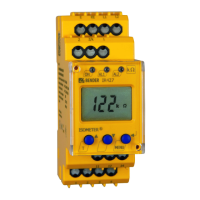
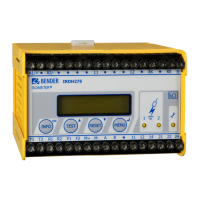

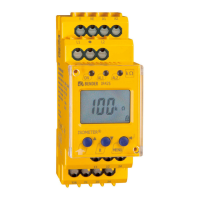

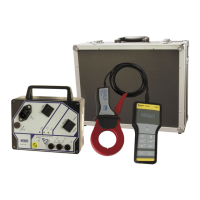
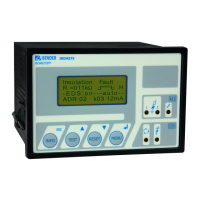

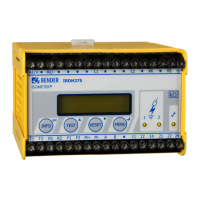
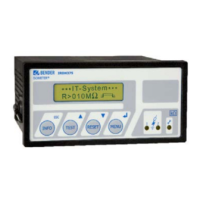
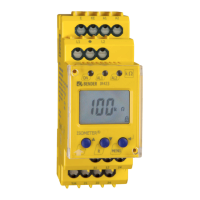
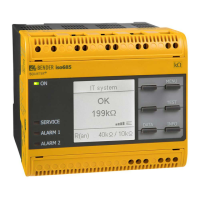
